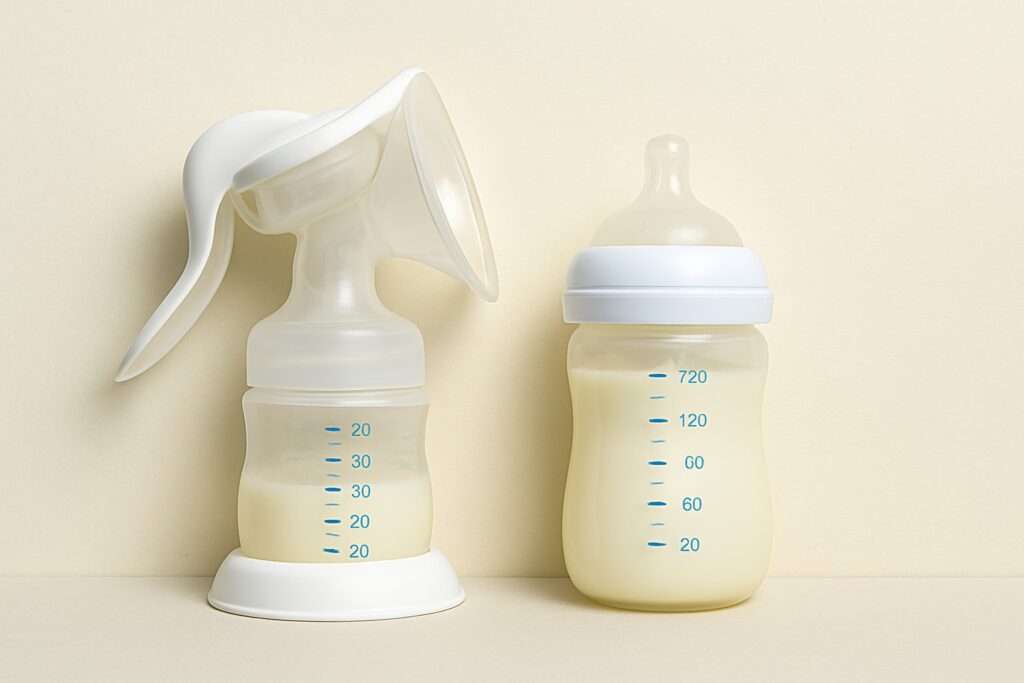- Contact:
- +971 4 26 68 222
- +971 50 3860 777

When it comes to feeding a newborn, many parents ask the same critical question: “Should I feed my baby on a schedule or whenever they seem hungry?” The answer isn’t always clear cut. Feeding is one of the first ways a parent meets their baby’s needs, and it plays a big role in growth, bonding, and even sleep patterns.
Let’s take a closer look at the difference between these two methods and how to know what’s best for your newborn care.
On demand feeding means you feed your baby whenever they show signs of hunger, whether that’s every hour or every three hours. It relies on recognizing hunger cues such as lip smacking, rooting, or crying. The baby sets the schedule and parents follow their lead.
Scheduled feeding, on the other hand, follows a set routine. For example, feeding every two or three hours, regardless of the baby’s cues. This method is often used to establish structure, especially in situations where caregivers share responsibilities or the baby is in a childcare setting.
The Mayo Clinic explains, “Feeding on demand helps babies feel secure and satisfied, and it often results in better weight gain during the first few weeks.”
On Demand Feeding
Scheduled Feeding
The best approach can change based on the baby’s age, weight, and health condition. During the first few weeks, on demand feeding is often preferred, especially for breastfeeding.
The UAE Ministry of Health and Prevention (MOHAP) recommends feeding babies 8 to 12 times in a 24 hour period during the early days, following the baby’s cues. However, in medical situations like when a baby is underweight or jaundiced, a doctor may advise waking the baby to feed every 2 to 3 hours.
Some signs it may be time to consider scheduled feeding:
Flexibility is key. Many parents find that a hybrid method, structured feeding during the day and on demand feeding at night, works best.
To follow an on demand method effectively:
If you prefer a scheduled routine:
This approach combines both methods:
Nighttime: Feed based on baby’s hunger cues to allow better sleep and bonding
Always consult your pediatrician or a certified lactation consultant if you’re unsure about your baby’s feeding pattern. In the UAE, services are available through DHA hospitals, MOHAP clinics, and private home healthcare providers like Eureka Home Healthcare, who offer lactation and at home consultation support services.

Here’s a quick comparison to help you decide:
Consideration | On Demand Feeding | Scheduled Feeding |
Hunger cues | Always followed | Sometimes delayed |
Predictability | Low | High |
Suitable for | Breastfeeding, bonding, early weeks | Structured environments, medical needs |
Risk of over or underfeeding | Low | Moderate |
Parent convenience | Variable | Often higher |
One of the biggest concerns for new parents, especially when breastfeeding, is whether their baby is getting enough milk. The good news is that your baby will show you in several ways.
Here are the signs to look for:
If your baby needs help gaining weight, feeding technique and timing are essential.
Tips to support healthy weight gain:
If you’re bottle feeding:
“The key to weight gain is ensuring babies are feeding effectively and getting full feeds, not just frequent short snacks,” says a lactation consultant at Johns Hopkins.
Breast milk changes during a feed. The milk at the beginning is called foremilk and is more watery and thirst quenching. As the baby continues feeding, the milk becomes richer in fat. This is called hindmilk.
Why hindmilk is important:
How to ensure your baby gets hindmilk:
Note: There’s no need to time feeds rigidly. Watch your baby’s cues and allow them to finish one side at their own pace.
While most feeding challenges resolve with time, reach out to a healthcare provider if:
In Dubai and the UAE, you can contact home healthcare services like Eureka Home Health Care, or visit your nearest DHA pediatric clinic for support.
No two babies are alike, and neither are families. What matters most is that your baby is growing well, has enough wet diapers, and seems satisfied after feeding. On demand feeding respects your baby’s natural rhythm and builds trust, while scheduled feeding can offer structure for busy households.
Many experts suggest starting with on demand feeding and adjusting as needed. “It’s not about choosing one method forever,” says the Mayo Clinic, “but responding to your baby’s changing needs with flexibility.”
By tuning in to your baby’s signals and using professional guidance when needed, you’ll find the approach that works best for both of you.
Need Help with Feeding or Baby Care
If you ever feel unsure or need extra support with your baby’s feeding routine, Eureka Home Health Care is here to help. Our certified lactation consultants can visit you at home to guide you through every step. Whether it’s checking your baby’s weight, helping with latching, or answering feeding questions, we make sure you and your baby feel safe and supported in the comfort of your own home.
In the home setting, Nurses play an integral role in the delivery of quality healthcare services that generates trust and collaboration for both the care of the client and the maintenance of health of other family members as well.
Office 107, Business Point Building, Port Saeed, Dubai, United Arab Emirates
Mob : +971 50 3860 777
Tel : +971 4 26 68 222
© 2023 Copyright Eureka Home Health Care | Patient Rights | All rights reserved.
MOH APPROVAL # 17GKT9GT-040725